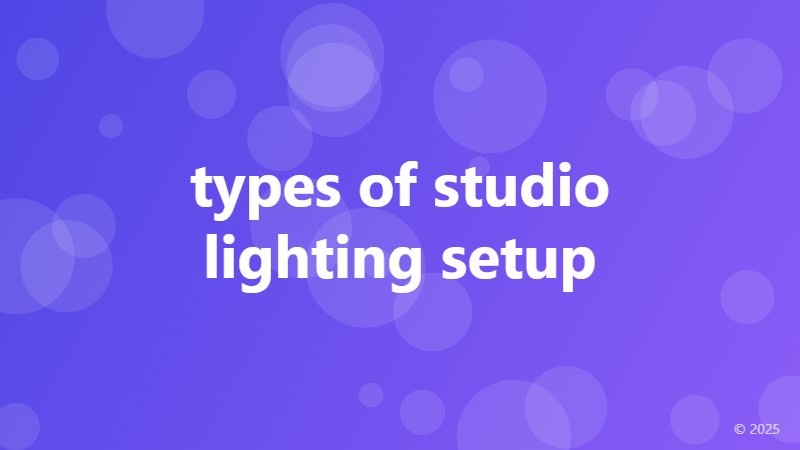types of studio lighting setup

Understanding the Basics of Studio Lighting Setup
When it comes to photography, lighting is one of the most critical elements that can make or break an image. A well-lit subject can bring out the best in the image, while poor lighting can result in unflattering shadows and an unappealing atmosphere. In a studio setting, having the right lighting setup is crucial to achieving professional-looking results. In this article, we'll explore the different types of studio lighting setups and how they can be used to create stunning images.
1. Natural Light Setup
One of the most popular types of studio lighting setups is the natural light setup. This setup involves using natural light as the primary source of illumination. This can be achieved by placing the subject near a window or using a translucent panel to diffuse the light. Natural light setups are ideal for capturing soft, warm, and flattering images, especially for portraits and still-life photography.
2. Single-Light Setup
A single-light setup involves using a single light source to illuminate the subject. This can be achieved using a strobe or a continuous light source. Single-light setups are great for creating dramatic and moody images, especially for low-key portraits and product photography.
3. Two-Light Setup
A two-light setup involves using two light sources to illuminate the subject. This can be achieved by using two strobes or a combination of a strobe and a continuous light source. Two-light setups are ideal for creating balanced and well-lit images, especially for portraits and full-body photography.
4. Three-Point Lighting Setup
A three-point lighting setup involves using three light sources to illuminate the subject. This setup typically consists of a key light, fill light, and backlight. The key light is used to illuminate the subject's face, the fill light is used to soften the shadows, and the backlight is used to separate the subject from the background. Three-point lighting setups are ideal for creating well-lit and dimensional images, especially for portraits and product photography.
5. High-Key Lighting Setup
A high-key lighting setup involves using a bright and even lighting to create a minimalist and clean look. This setup is achieved by using multiple light sources to illuminate the subject, resulting in a low-contrast image with minimal shadows. High-key lighting setups are ideal for capturing bright and airy images, especially for fashion and beauty photography.
6. Low-Key Lighting Setup
A low-key lighting setup involves using a single light source to create a dramatic and moody atmosphere. This setup is achieved by using a single light source to illuminate the subject, resulting in a high-contrast image with deep shadows. Low-key lighting setups are ideal for capturing dramatic and intense images, especially for portraits and fine-art photography.
In conclusion, the type of studio lighting setup used can greatly impact the final result of an image. By understanding the different types of studio lighting setups, photographers can choose the right setup to achieve the desired mood and atmosphere in their images. Whether you're a professional photographer or an enthusiast, experimenting with different studio lighting setups can help take your photography skills to the next level.